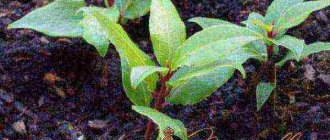Rosemary is known for its unique taste. It is often used in cooking. In folk in medicine the plant is used for care for skin, hair, and also for the treatment of diseases of the respiratory system.
Know that if you decide to acquire such a useful plant as rosemary , growing it in an apartment is a labor-intensive but exciting process.
How to plant rosemary on a windowsill: features, conditions and step-by-step instructions
Growing homemade rosemary is a rather labor-intensive process and requires compliance with all conditions. If you deviate from the rules of care, the plant begins to quickly lose its decorative properties, diseases appear , and the shrub loses all its medicinal and taste qualities.
Read more about how to plant rosemary at home.
Growing space
Rosemary can be grown in any room in the apartment. It releases essential substances and has a beneficial effect on the health of household members , and in the kitchen it will become a beautiful interior decoration.
Important! The smell of the twigs promotes calm and relieves nervous tension, which allows you to place the plant both in the work area and in a place of rest.
Before you start growing indoor spices, you need to assess the light conditions in the apartment and, if necessary, install additional lighting .
If the pot stands motionless on the window for a long time, then the crown begins to grow unevenly. To prevent this, rosemary is turned with the opposite side towards the light source once every 2-3 days.
Temperature
The temperature depends on the season. In summer, fresh air with a temperature of 20 to 25 degrees . If you place rosemary on the balcony, it will be provided with daily temperature fluctuations, which brings the growing conditions as close as possible to natural ones.
In winter, the grass needs coolness, and a temperature drop of 10–15 degrees is acceptable. Such conditions contribute to abundant flowering in the spring.
Important! The main rule is to avoid sudden temperature changes and drafts. When ventilating, the pot with the plant must be removed from the window, and in the spring it must be gradually accustomed to high temperatures.
Illumination
Indoor herbs do not accept shady places, so rosemary is placed on the windowsill in the southern part of the house. You can choose a southwest or southeast window, but additional light will be needed .
It is important that the pot must be intensively illuminated for at least 6 hours a day. If there is not enough natural light, especially in winter , the installation of light lamps suitable for greenery is required. You can also use the diffused white light of LED lamps.
Growing pot
Rosemary roots branch well, so the flowerpot should be spacious . It is desirable that its width exceeds its height (for example, 25x20 cm).
The most suitable material would be clay or ceramics, as they are able to pass air to the roots deep in the soil. Large holes are required at the bottom for water drainage.
Before planting, it is necessary to additionally cover the bottom with a layer of expanded clay or large stones, which will prevent the earthen ball from coming into contact with moisture.
What soil to plant in, substrate
The soil for rosemary in a pot should be very loose, easily permeable to air and moisture. In addition, the soil needs to be hilled frequently , providing the deep layers of roots with access to air.
For planting, universal soil for seedlings or ordinary soil from the garden is suitable. In order to increase looseness, a quarter of the volume of the substrate is supplemented with sand or perlite.
You can make a more nutritious composition for rosemary yourself from the following components:
- leaf and turf soil (4 parts);
- humus (1 part);
- sand and peat (1 part each).
The finished soil should be slightly alkaline or neutral.
Before planting, any land requires disinfection from bacteria and insect pests. The soil for this purpose is spilled with a weak manganese solution or calcined in the oven.
Seed preparation
Rosemary seeds have low germination rate, and it is very difficult to grow a plant from them on the first try. If you are determined to bring the idea to completion , then you first need to prepare everything correctly.
Growing rosemary from seeds is carried out in late winter - early spring , so that the sprout has the most comfortable conditions for growth.
Following actions:
- Wrap the seeds in 2 layers of damp gauze, placing them on one half and covering the other.
- Let stand for 2-3 days, then plant on moist soil, without falling asleep on top.
- Cover the crops with film or a mini-greenhouse.
- Open every day for 20–30 minutes, spray with warm and soft water from a spray bottle.
- You can wait up to 1 month for sprouts, after which, if there are no sprouts, you will have to do everything again.
- the emerging sprouts in the greenhouse , spray and ventilate. The lighting should be artificial, with white diffused light, so that the stem does not stretch.
- From strong sprouts with 2 leaves, the greenhouse can be gradually removed, increasing the time of usual soil ventilation every day.
- Young plants prick carefully, reaching at least 10 cm in length .
- They should be transplanted into separate pots by summer so that active growth is not hampered by cramped containers.
Preparing cuttings for planting, their germination
Growing in an apartment using cuttings is much easier. You can get them from an adult plant or buy them already rooted in garden centers in the spring.
To make the cutting yourself, cut a twig 7–10 cm long from the top of the bush at an acute angle. The stem is chosen with lignified bark , which absorbs water well. The lower leaves are cut off at 1/3 of their length.
There are 2 ways to germinate a cutting:
- Place in a container with water. The liquid should cover a quarter of the plant , this will prevent the leaves from falling off.
- Plant the cuttings in damp sand or a mixture of peat and perlite, periodically moistening it with a sprayer.
With any method, the container with cuttings is placed in a well-lit place without access to direct sunlight. Throughout the germination period, high humidity of the stem is maintained by spraying and the temperature is 18–22 degrees.
The appearance of the first roots is expected in 3 weeks , and after they grow, the cuttings are transplanted into loose soil. Further, the sprouts require careful care.
Advice! In order for the new plant to begin to bush and not stretch upward, the apical bud must be pinched after transplanting into a pot.
This video tells you how to grow Rosemary at home from cuttings and where to get these cuttings.
Step by step guide
Growing rosemary at home in a pot is not an easy task; proper conditions must be observed. If they are violated, the plant will begin to hurt and lose its decorative, taste and medicinal properties. The presence of homemade rosemary will help relieve nervous stress in your household and make them calmer.
Attention!
An important condition is the penetration of sunlight into the apartment. If it is not enough, you need to take care of organizing additional lighting.
A flower standing in one place for a long time without moving will grow unevenly. Therefore, from time to time it should be turned to the opposite side towards the light source. Rosemary is propagated by seeds, cuttings and dividing an adult bush.
How to care for rosemary after planting and before harvesting
After planting, it is important to keep the plant in good conditions so that diseases do not appear on it and it is edible.
Watering
Rosemary prefers moderately moist soil. The watering regime is regular , as the top layer of soil is ventilated.
On a note! It is better to keep the plant in drier soil than to flood it with water.
If there is excess moisture, diseases will quickly arise, and if there is too little, rosemary will stop growing and begin to lose its decorative appearance .
In winter, when the temperature drops, rosemary needs a minimal amount of water, but when kept on a heated windowsill, it is important to prevent the formation of a dry earthen lump.
Top dressing
A young plant in the active growth phase needs fertilizing with mineral fertilizers twice a month.
Important! If the soil initially contains humus or vermicompost, then you should start fertilizing it no earlier than a month after transplanting.
Transfer
If it is possible to transplant the plant into open ground for the summer, then you should definitely do it. Outdoors in a well-lit place ensures full growth.
After purchase and until the age of three, rosemary is transplanted once a year into a larger pot.
An adult plant needs annual renewal of the top layer of soil , and once every 3 years it is transplanted into a larger pot and the substrate is completely changed.
Rosemary is transplanted by transshipment.
Algorithm of actions:
- On the eve of transplantation, spill the pot with plenty of water, paying special attention to the soil near the walls.
- Turn the pot down, holding the trunk with your fingers, shake out the earthen lump.
- the bottom of the new container with a drainage layer and 2–3 cm of substrate .
- Place an intact earthen ball with roots in the center and fill the edges with soil.
- Leave the pot for 2-3 days in a shaded place, then move it to a permanent location.
Trimming, pinching
If you do not trim the apical parts of the shoots, the rosemary will quickly stretch out and become unattractive.
Using a sharp pruner, having previously disinfected it with an alcohol solution , cut off from a quarter to a third of the length of the trunks. This stimulates branching.
Advice! If the rosemary is still short, you can simply pinch the top bud to stop its growth and give rise to side branches.
How to get a harvest
The flowers, like the rest of the plant, are used for cooking. With their help, you can harvest seeds and try to propagate rosemary .
Planting and caring for it at home does not immediately bear fruit: the plant may begin to bloom a year after the seedlings emerge from the seeds on the windowsill or the next season after the cuttings have rooted.
The main reasons for the lack of flowering on a healthy plant may be:
- keeping rosemary indoors in winter. Failure to reduce the temperature to 10–12 degrees for at least a month prevents rest and the formation of flower buds;
- lack of nutrients in the soil or a cramped pot. To prevent this cause, you need to replant young rosemary annually into a new substrate, preferably adding humus or peat to it, while simultaneously increasing the volume of the pot.
Methods for propagating rosemary
Planting rosemary, as well as growing it, is not difficult. There are various ways to propagate shrubs.
- Using seeds. This method requires careful preparation of planting material and soil. Rosemary seeds need to be processed to ultimately increase germination. Seedlings need constant care and a special microclimate. After they grow up, they should be sent outside.
- Cuttings. It is necessary to cut off the top of an adult plant and then root it in a previously prepared substrate. Having provided a number of conditions, the cuttings will form roots, after which they can be planted.
- Twigs. Cut branches of the plant are placed in water and wait for roots to appear. Afterwards, the seedlings are left in the pot or taken outside.
- By division. The method used when transplanting rosemary is to divide the roots into several parts and plant them in different pots.
- By layering. One of the branches of the plant is bent, without tearing it away from the bush, and sprinkled with earth. After some time, it develops its own roots, after which the cuttings can be separated from the mother bush.
Reproduction
Main problems when growing
Gardeners, when deciding how to grow rosemary at home, are faced with the main problems of watering intensity and lighting:
- Excessive watering leads to yellowing of the leaves. If you continue to waterlog the soil, there is a high probability of powdery mildew ;
- lack of moisture is manifested by falling leaves, and dry air is a favorable environment for the development of spider mites;
- weak growth and elongation of shoots is observed with insufficient lighting intensity or lack of fertilizers.
Due to the rich content of essential oils, rosemary is not susceptible to insects, but pests may appear on a weakened plant.
This video explains how to care for Rosemary at home.
About varieties
As mentioned above, medicinal ordinary rosemary is divided into several varieties, which differ in flowering (the color of the flowers can be different), the shade of the leaves, size and character.
The following varieties of rosemary are best suited for growing indoors:
- "Lavender",
- “Tenderness”, the cultivation of which from seeds gives the most successful results,
- the varieties “Rosinka” and “Roseus” also take root quite well in apartments.
But in general, there are no restrictions on varieties; you can try to grow any shrub of the “common rosemary” species.
Diseases and pests
If the watering regime is violated, temperature changes and poor air exchange in the room, rosemary is susceptible to diseases and pests.
Spider mite
Spider mites appear as a whitish coating on the lower part of the leaves and a thin web on the branches.
Considering that the mite parasitizes in dry air , the problem is often combined with leaf falling.
Infection most often occurs from other plants on the windowsill or from open ground in the summer.
The fight consists of removing damaged leaves or washing off plaque with a solution of laundry soap. Treatment is carried out with insecticidal preparations (for example, Fitoverm).
Mildew
The disease is expressed by a fine white coating on the leaves. The occurrence is provoked by excess soil and air moisture. In the early stages, normalizing microclimate and removing damaged branches will help.
Important! If dew continues to develop, then spraying with an antifungal agent is required.
It should be borne in mind that the seasoning should not be eaten after chemicals, since harmful substances are stored not only on the leaves, but are also absorbed internally.
Application of the plant
The most common use of rosemary is in cooking. Coniferous taste and aroma are used in the preparation of sauces for meat (especially pork and lamb) and marinades. Rosemary is becoming popular in baking and dessert recipes.
Brewed twigs are added to tea, especially often during colds. At this time, the plant is most useful due to the content of a large amount of essential oils and vitamin C.
In folk medicine, rosemary is used for stomatitis, as well as in the treatment of gynecological diseases and diseases of the respiratory system.
Rosemary is quite sensitive to conditions . But if you follow them, a very healthy and tasty plant will appear in your house.
Medicinal properties
On the human body, rosemary has an anti-inflammatory and tonic effect, bile and diuretic. Promotes wound healing and relieves spasms. Rosmarinic acid, as the most powerful antioxidant, increases immune defense.
The most valuable essential oil is that it heals skin diseases: eczema, scabies, burns and rashes.
The use of rosemary is indicated for colds and coughs, asthma and throat diseases. It is taken for low blood pressure and heart diseases. Baths are prepared with the branches for those suffering from radiculitis and rheumatism, and sore spots are rubbed with ointments with rosemary. Baths increase blood circulation and eliminate the feeling of heaviness in the legs.
Rosemary helps overcome depression and eliminate nervousness, recover from a stroke, improve the functioning of the digestive system and normalize metabolism. As an effective antiseptic, rosemary is included in toothpastes.
Head massage with essential oil has a beneficial effect on the brain and weak memory, and enhances mental activity. Helps prevent age-related changes and Alzheimer's disease.
Rosemary is added to cosmetic preparations to rejuvenate the skin and treat hair. Rosemary oil cleanses the skin of acne and enlarged pores, and helps whiten the skin. Rosemary oil is good for hair and scalp, which it tones and disinfects. After using it, hair falls out less and grows well, dandruff disappears. Compositions with essential oil are applied to the body for cellulite to smooth out bumps on the skin.
Rosemary is contraindicated in case of high blood pressure, a tendency to seizures and epilepsy, during pregnancy and exacerbation of peptic ulcers, and with renal and liver failure.











